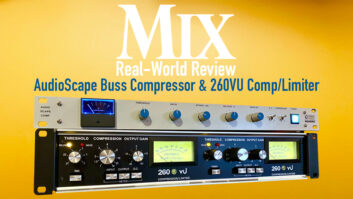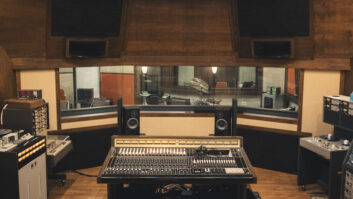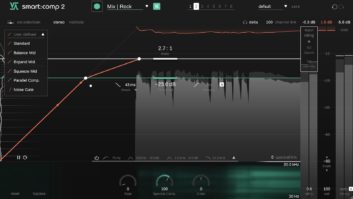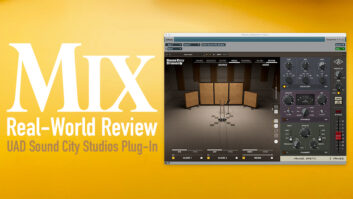In 2001, Groove Tubes established a beachhead in the high-end market with its ViPRE mic preamp, an all-tube unit with specialized features such as variable rise time, input impedance and a VU with five display settings. Not to be outdone, Groove Tubes has set another high standard with its Glory Comp variable transconductance compressor. Loaded with features and built like a tank, the Glory Comp is a one-of-a-kind dynamics controller.
NO GUTS, NO GLORY
Glory Comp’s wiring, component layout, all-triode circuitry, beefy power supply and transformers point to adept technical design and execution. Outside, anyone familiar with ViPRE will be at home with Glory Comp’s look and feel. The black aluminum faceplate, retro control knobs and easy-to-read labels give it a decided military look, while chrome carrying handles facilitate transporting this 37-pound beast.
Controls range from what you’d expect to others — such as the Heaven and Earth “Glory” controls — that beg explanation. The top row of controls carry adjustments for input (-20 dB to +10 dB), threshold (-21 dB to +9 dB), attack (1 ms to 250 ms), release (50 ms to 2 seconds with a logarithmic/ linear toggle), ratio (1:1 to 6:1 stepped logarithmically in 11 increments) and output (-20 dB to +10 dB). A Link toggle lets the unit act as master or slave when connected to a second Glory Comp. The sidechain EQ operates on internal sidechain sources only, with a 2-band 10dB boost/cut at either 50 Hz or 10k Hz.
The Glory control lets users add even harmonics between 40 Hz and 700 Hz. This effect is added to the compressed signal at the output stage, providing the ability to add presence and a bit of “hair” (distortion) to the signal. The meter knob has nine positions and controls what the large circular VU meter is reacting to. When set to Meter output, the unit offers four settings (0 dB, +4 dB, +8 dB and +20 dB); the gain reduction position offers a x1 and x2 setting; and the input setting reads either the program or sidechain input. A built-in 330Hz oscillator aids in setting two recessed balance pots, marked Plate and Cathode. These can be used to trim the push-pull signal levels when changing the two variable transconductance tubes or tweaking bias as the tubes naturally age. Lastly, toggles control power on/off and hard bypass.
The rear panel has XLR and TRS jacks for input and output. The TRS inputs are 6 dB more sensitive than the XLRs. Two TRS Control Voltage (CV) jacks (input, output and thru) allow daisy-chaining up to six Glory Comps. Yes! You can use these units in a surround setup, provided you have enough equity in your home. There are also XLR and TRS jacks for sidechain input, output and throughput, and, lastly, a fuse and an IEC AC connector.
GLORY, GLORY — HALLELUJAH!
My first test for the Glory Comp was on a bass guitar patched across the insert of an SSL 4000 G+ console headed to tape. I began with the recommended settings in the supplied Quick Start guide. I had to crank the input pretty hard to get the gain reduction I wanted, but the unit has plenty of headroom and didn’t wince when I asked it to work. I matched the output — flipping the hard bypass back and forth — for a quick A/B, and the bass achieved a beautiful warmth and roundness that made it sit down and shake hands with the kick drum.
I could further adjust the tone, adding more presence and fullness, by turning the Glory control more toward the Heaven setting. For bass on this track, Glory worked best when I took it just beyond where I could hear it and then backed it off a bit. For the most part, even at near-extreme settings, it was hard to make the unit sound bad, although Heaven became less-than-heavenly when set fully clockwise. Even so, if you’re looking for a sound with pushed, distorted midrange, this is not a bad way to go.
It’s no wonder that the Glory Comp sounds great on low-frequency material. According to the designers, the its control circuitry was designed to bridge the gap between electronic and optical gain-reduction compressors. When an electronic compressor’s attack and release controls are set to intervals approaching or equal to the time period of the wave it is trying to control, non-musical artifacts are generated. According to the Glory Comp manual, “Low-frequency phase splitting circuitry is applied to the varying program signal voltage sample before being presented to the compressor’s rectifier circuit. The LF signal content is then full wave — rectified by two separate peak rectifier circuits. The result is four or more peak events per cycle of bass signal content, creating a far smoother DC control voltage for modulating the variable gain circuitry.” The result is a more “optical” smoothness when compressing bass signals, but without the speed and control restrictions inherent in an optical approach.
I used the Glory Comp on tenor and soprano sax with equally good results. The tenor sounded lush and full at all dynamic levels, and on this tune, it worked best with a medium-fast attack with a long release. The Glory Comp gave the often-strident soprano a nice, silky, round smoothness and let me back off the overall volume while still having it dominant in the track.
This unit was made for lead vocals. It pushed the vocal right up front in the mix, making the inexpensive mic through which it was recorded sound better than it deserved. I added just a bit of Heaven and the vocal filled out the allotted space in the mix. Once again, I found best results by taking it beyond tasteful and then backing off a bit. But with backgrounds purposefully recorded at narrow bandwidth, compressed hard and then set at a low volume in the mix, an extreme Heaven setting was just the ticket.
Next, I tried the unit on a single Neumann U87 set five feet above and behind a drum kit. I could manipulate the amount of room in the mix by crunching this track at maximum ratio with a long decay and then pushing the input until the ambience was just where I wanted it. As the unit can provide a full 20 dB of gain, be careful that the output control is set optimally so you don’t overload your insert return to the console.
Distorted guitar sounded full yet controlled, allowing me to flatten the dynamic range and make room for the vocal without losing tone. I might sound like a broken record, but the Glory control came to the rescue once again, allowing me to alter the tone, adding presence and beef in the critical low to mid range without adding EQ.
Lastly, the Glory Comp set to a relaxed 3:1 ratio with a few dB of gain reduction took the bite out of an acoustic guitar that was played with uneven dynamics. The unit is a true master of many situations, and although I only had one unit, I believe it would excel as a bus compressor.
SIMPLY GLORIOUS
The Groove Tubes Glory Comp is a neoclassic in the mold of the Fairchild and LA-2A. It can impart buttery, warm gain reduction to whatever it touches. In my tests, it especially excelled on bass, vocals, guitars and sax, and was an excellent cruncher for a room feed when recording a drum kit.
It only takes a look and listen to justify plunking down $3,499 for this excellent tone-shaper. It is an engineering masterpiece inside and out. From the military-grade knobs and buttons to the well-thought-out and executed internal circuitry, the Glory Comp reeks of quality. Anyone wanting to add an excellent, one-of-a-kind compressor to their rack should run — not walk — to their local dealer.
Groove Tubes, 818/361-4500, www.groovetubes.com.
Kevin Becka is Mix’s technical editor.







